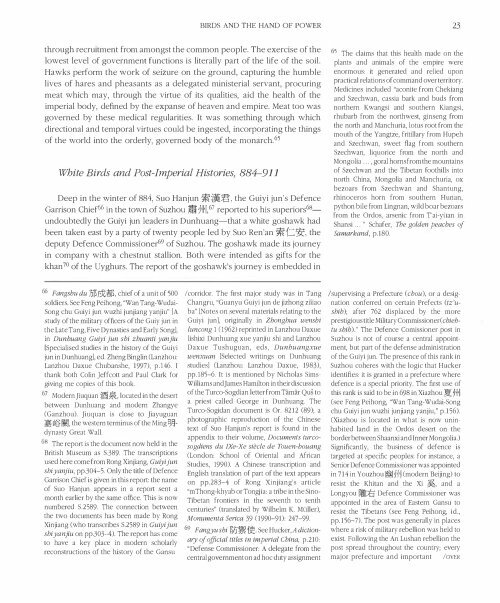East Asian History - ANU
East Asian History - ANU
East Asian History - ANU
- No tags were found...
You also want an ePaper? Increase the reach of your titles
YUMPU automatically turns print PDFs into web optimized ePapers that Google loves.
BIRDS AND THE HAND OF POWER23through recruitment from amongst the common people. The exercise of thelowest level of government functions is literally part of the life of the soil.Hawks perform the work of seizure on the ground, capturing the humblelives of hares and pheasants as a delegated ministerial servant, procuringmeat which may, through the virtue of its qualities, aid the health of theimperial body, defined by the expanse of heaven and empire. Meat too wasgoverned by these medical regularities. It was something through whichdirectional and temporal virtues could be ingested, incorporating the thingsof the world into the orderly, governed body of the monarch.65White Birds and Post-Imperial Histories, 884-911Deep in the winter of 884, Suo Hanjun %'¥, the Guiyi jun's DefenceGarrison Chief66 in the town of Suzhou Jffif 1+[,67 reported to his superiors68-undoubtedly the Guiyi jun leaders in Dunhuang-that a white goshawk hadbeen taken east by a party of twenty people led by Suo Ren'an %'1=, thedeputy Defence Commissioner69 of Suzhou. The goshawk made its journeyin company with a chestnut stallion. Both were intended as gifts for thekhan70 of the Uyghurs. The report of the goshawk's journey is embedded in65 The claims that this health made on theplants and animals of the empire wereenormous: it generated and relied uponpractical relations of command over territory.Medicines included "aconite from Chekiangand Szechwan, cassia bark and buds fromnorthern Kwangsi and southern Kiangsi,rhubarb from the northwest, ginseng fromthe north and Manchuria, lotus root from themouth of the Yangtze, fritillary from Hupehand Szechwan, sweet flag from southernSzechwan, liquorice from the north andMongolia ... , goral horns from the mountainsof Szechwan and the Tibetan foothills intonorth China, Mongolia and Manchuria, oxbezoars from Szechwan and Shantung,rhinoceros horn from southern Hunan,python bile from Lingnan, wild boar bezoarsfrom the Ordos, arsenic from T'ai-yiian inShansi ... " Schafer, The golden peaches ofSamarkand, p.180.66 Fangshu du }jJl0(;:W, chief of a unit of 500soldiers. See Feng Peihong, "Wan Tang-WudaiSong chu Guiyi jun wuzhi junjiang yanjiu" [Astudy of the military officers of the Guiy jun inthe Late Tang, Five Dynasties and Early Song],in Dunhuang Guiyi jun shi zhuanti yanjiu[Specialised studies in the history of the Guiyijun in Dunhuangl, ed. Zheng Binglin (Lanzhou:Lanzhou Daxue Chubanshe, 1997), p.l46. Ithank both Colin Jeffcott and Paul Clark forgiving me copies of this book.67 Modern Jiuquan , located in the desertbetween Dunhuang and modern Zhangye(Ganzhou). Jiuquan is close to JiayuguanJ{; m 1m, the western terminus of the Ming fj}3dynastyGreat Wall.68 The report is the document now held in theBritish Museum as S.389. The transcriptionsused here come from Rong Xinjiang, Guiyi junshi yanjiu, pp.304-5. Only the title of DefenceGarrison Chief is given in this report: the nameof Suo Hanjun appears in a report sent amonth earlier by the same office. This is nownumbered S.2589. The connection betweenthe two documents has been made by RongXinjiang (who transcribes S.2589 in Guiyijunshi yanjiu on pp.303-4)' The report has cometo have a key place in modern scholarlyreconstructions of the history of the Gansu!corridor. The first major study was in TangChangru, "Guanyu Guiyi jun de jizhong ziliaoba" [Notes on several materials relating to theGuiyi jun], originally in Zhonghua wenshiluncong 1 (1962) reprinted in Lanzhou Daxuelishixi Dunhuang xue yanjiu shi and LanzhouDaxue Tushuguan, eds, Dunhuangxuewenxuan [Selected writings on Dunhuangstudiesl (Lanzhou: Lanzhou Daxue, 1983),pp.185-6. It is mentioned by Nicholas SimsWilliams and James Hamilton in their discussionof the Turco-Sogdian letter from Tamar Qus toa priest called George in Dunhuang. TheTurco-Sogidan document is Or. 8212 (89); aphotographic reproduction of the Chinesetext of Suo Hanjun's report is found in theappendix to their volume, Documents turcosogdiensdu IXe--Xe siecle de Touen-houang(London: School of Oriental and AfricanStudies, 1990). A Chinese transcription andEnglish translation of part of the text appearson pp.283-4 of Rong Xinjiang's article"mThong-khyab or Tongjia: a tribe in the SinoTibetan frontiers in the seventh to tenthcenturies" (translated by Wilhelm K. Miiller),Monumenta Serica 39 (1990-91): 247-99.69 Fangyushi WJ fJ!!. See Hucker, A dictionaryof offiCial titles in imperial China, p.210:"Defense Commissioner: A delegate from thecentral government on ad hoc duty assignmentIsupervising a Prefecture (chou), or a designationconferred on certain Prefects (tz'ushih);after 762 displaced by the moreprestigious title Military Commissioner (chiehtushih)." The Defence Comissioner post inSuzhou is not of course a central appointment,but part of the defense administrationof the Guiyi jun. The presence of this rank inSuzhou coheres with the logic that Huckeridentifies: it is granted in a prefecture wheredefence is a special priority. The first use ofthis rank is said to be in 698 in Xiazhou I 1+1(see Feng Peihong, "Wan Tang-Wudai-Songchu Guiyi jun wuzhi junjiang yanjiu," p.156).(Xiazhou is located in what is now uninhabitedland in the Ordos desert on theborder between Shaanxi and Inner Mongolia.)Significantly, the business of defence istargeted at specific peoples: for instance, aSenior Defence Commissioner was appointedin 714 in Youzhou jHj'I'.(modern Beijing) toresist the Khitan and the Xi , and aLongyou 1liIi:i Defence Commissioner wasappointed in the area of <strong>East</strong>ern Gansu toresist the Tibetans (see Feng Peihong, id.,pp.156-7). The post was generally in placeswhere a risk of military rebellion was held toexist. Following the An Lushan rebellion thepost spread throughout the country; everymajor prefecture and important lOVER
















